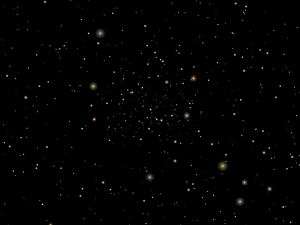NGC 188
| NGC 188 | |
|---|---|
|
NGC 188 | |
| Observation data (J2000 epoch) | |
| Constellation | Cepheus |
| Right ascension | 00h 48m 26s[1] |
| Declination | +85° 15.3′[1] |
| Distance | 5,400 ly[2] (1.66 kpc) |
| Apparent magnitude (V) | 10.0 [3] |
| Apparent dimensions (V) | 15′ |
| Physical characteristics | |
| Radius | unknown |
| Other designations | Cl Melotte 2,[1] Caldwell 1 |
NGC 188 is an open cluster in the constellation Cepheus. It was discovered by John Herschel in 1825. Unlike most open clusters that drift apart after a few million years because of the gravitational interaction of our Milky Way galaxy, NGC 188 lies far above the plane of the galaxy and is one of the most ancient of open clusters known, at approximately 6.8 billion years old.[4] NGC 188 is very close to the North Celestial Pole, under five degrees away, and in the constellation of Cepheus at an estimated 5,000 light year distance, this puts it slightly above the Milky Way's disc and further from the center of the galaxy than the Sun.
See also
- Nature timeline
References
- 1 2 3 "NGC 188". SIMBAD. Centre de données astronomiques de Strasbourg. Retrieved 2006-12-08.
- ↑ Bonatto, C.; Bica, E.; Santos, J. F. C., Jr. (2005). "Spatial dependence of 2MASS luminosity and mass functions in the old open cluster NGC 188". Astronomy and Astrophysics. 433 (3): 917–929. arXiv:astro-ph/0502453
 . Bibcode:2005A&A...433..917B. doi:10.1051/0004-6361:20041113.
. Bibcode:2005A&A...433..917B. doi:10.1051/0004-6361:20041113. - ↑ Clark, R. N. (1990). Visual Astronomy of the Deep Sky. p. 287. ISBN 0521361559.
- ↑ VandenBerg, D. A.; Stetson, P. B. (2004). "On the Old Open Clusters M67 and NGC 188: Convective Core Overshooting, Color‐Temperature Relations, Distances, and Ages". Publications of the Astronomical Society of the Pacific. 116 (825): 997–1011. Bibcode:2004PASP..116..997V. doi:10.1086/426340.
External links
- NGC 188 at SEDS NGC objects pages
- NGC 188 at NightSkyInfo.com
- NGC 188 on WikiSky: DSS2, SDSS, GALEX, IRAS, Hydrogen α, X-Ray, Astrophoto, Sky Map, Articles and images
- NGC 188 at the SIMBAD Astronomical Database.
- Ids - Bibliography - Image - B&W Image.
Coordinates: ![]() 00h 48m 26s, +85° 15′ 18″
00h 48m 26s, +85° 15′ 18″
This article is issued from Wikipedia - version of the 6/27/2016. The text is available under the Creative Commons Attribution/Share Alike but additional terms may apply for the media files.
